www.GemstoneBasics.com
Photomicrography > Quartz > twinning & optic axis figures
First draft: March 4th, 2015 | Last update: March 24th, 2016
Twinning & optic axis figures (interference figures)
Brazil Law Twinning & Airy's Spiral in Amethyst, Artigas, Uruguay
The bull's eye - A conclusive observation to identify quartz
Brazil Law twinning has long been considered diagnostic for natural specimens. This fact, however, no longer holds true. New methods employed to synthesise quartz crystals in the lab (from a K2CO3 solution) have also resulted in twinned crystals. Despite the fact that inclusions could act as additional means in discerning natural crystals from synthesised ones, this also proved problematic.
The non-destructive analytical tool required to establish whether or not a given quartz is natural is by means of Fourier Transform InfraRed (FTIR) spectrometry. But simply reading peaks from the FTIR-spectrum does no longer suffise to solve the problem. Instead, assessment of the Full With at Half Maximum (FWHM) is the key factor to do so (Karampelas et al., 2011).
References and items of related interest
Karampelas, S. & Fritsch, E. (2004).
Infrared absorption as a useful tool to separate natural from synthetic amethysts.
Mitteilungen der Österreichischen Mineralogischen Gesellschaft, Vol. 149, p. 43.
Mitt. Österr. Mineral. Ges. Contents
Karampelas, S., Fritsch, E., Zorba, T., Paraskevopoulos, K.M., Sklavounos, S. (2005). Distinguishing natural from synthetic amethysts: the presence and true shape of the 3595 cm-1 peak. Mineralogy and Petrology, Vol. 85, Issue 1-2 (November), pp. 45-52. abstract + references
Karampelas, S., Fritsch, E., Zorba, T., Paraskevopoulos, K.M., Sklavounos, S. (2006). A refined infrared-based criterion for successfully separating natural from synthetic amethyst. Gems & Gemology: Proceedings of the 4th International Gemological Symposium & GIA Gemological Research Conference, August 2006, San Diego, California, Vol. 42, No. 3 (Fall), pp. 155-156.
Karampelas, S., Fritsch, E., Zorba, T., Paraskevopoulos, K.M., Sklavounos, S. (2007). An update in the separation of natural from synthetic amethysts. Bulletin of the Geological Society of Greece, Vol. 40, Proceedings of the 11th International Congress, Athens, May 2007, pp. 805-815.
Karampelas, S., Fritsch, E., Zorba, T. & Paraskevopoulos, K.M. (2011). Notes & New Techniques. Infrared spectroscopy of natural vs. synthetic amethyst: An update. Gems & Gemology, Vol. 47, No. 3 (Fall), pp. 196-201.
Khadzhi, V.E., Tsyganov, M.E., Tsinober, L.I., Novozhilova, Z.V., Reshetova, G.V., Samoilovich, M.I., Butuzov, V.P., Shaposhnikov, A.A. & Lelekova, M.L. (1977). Process for producing amethyst crystals. US Patent No. US4021294 A. Filed April 21st 1976, published May 3rd 1977.
Kitawaki, H. (2002). Natural amethysts from Caxarai mine, Brazil, with a spectrum containing an absorption peak at 3543cm−1. The Journal of Gemmology, Vol. 28, pp. 101-108.
Koivula, J.I. & Fritsch, E. (1989). The growth of Brazil-twinned synthetic quartz and the potential for synthetic amethyst twinned on the Brazil law. Gems & Gemology, Vol. 25, No. 3 (Fall), pp. 159-164.
Lameiras, F.S., Nunes, E.H.M. & Vasconcelos, W.L. (2009). Infrared and chemical characterizations of natural amethysts and prasiolites colored by irradiation. Materials Research, Vol. 12, No. 3 (July/September), pp. 315–320.
McMillena, C.D. & Kolisa, J.W. (2012). Bulk single crystal growth from hydrothermal solutions. Philosophical Magazine, Special Issue: Symposium on Design, Discovery and Growth of Novel Materials, Vol. 92, Issue 19-21, pp. 2686-2711. abstract
Nimi, N., Aikawa, N. & Shinoda, K. (1999).
The infrared absorption band at 3596 cm–1 of the recrystallized quartz from Mt. Takamiyama, southwest Japan.
Mineralogical Magazine, Vol. 63, No. 5, pp. 693–701.
Mineralogical Magazine Tables of Contents
Notari, F., Boillat, P.Y. & Grobon, C. (2001). Discrimination des améthystes et des citrines naturelles et synthétiques. Revue de Gemmologie, Association Française de Gemmologie, No. 141-142, pp. 75-80 (in French).
Photomicrographs
 LoRes.jpg)
Precisely parallel to the optic axis low-order interference colours emphasize Brazil Law twinning
18x (FoV ± 7mm) X-Pol
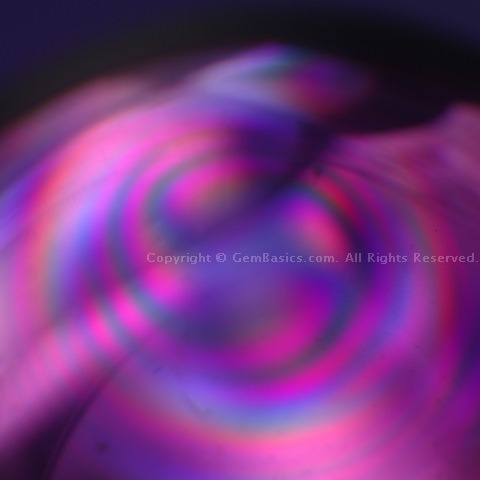
The conoscope reveals this Airy Spiral in a 3.28ct amethyst from Uruguay
X-Pol
Additionally, some impressions are shown here representing the typical features observed when quartz gems are oriented in the direction of their optic axis and viewed between crossed polarising filters.
At best, a harlequin pattern (left) is diagnostic for Brazil Law twinning, but mostly, only partially crossed patterns are observed as is the case in the other images.
However, without access to an FTIR spectrometer, conclusively discriminating between the natural or synthetic nature of the gem is no longer possible.
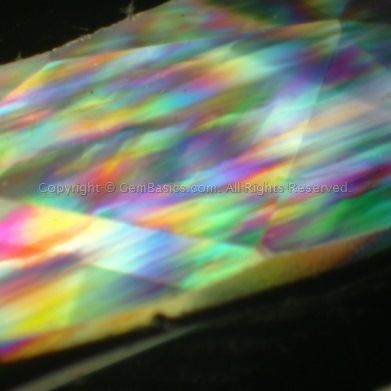
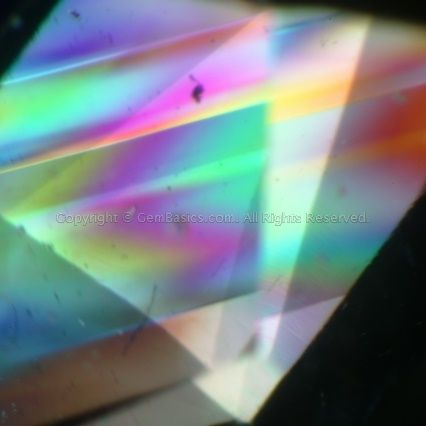
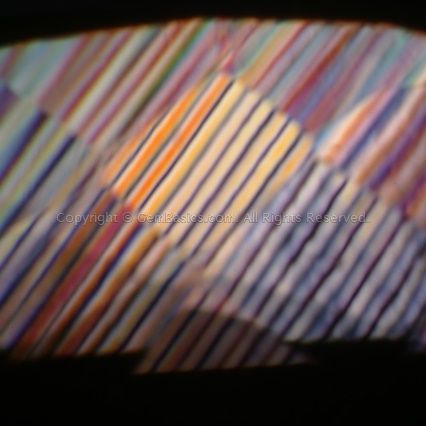
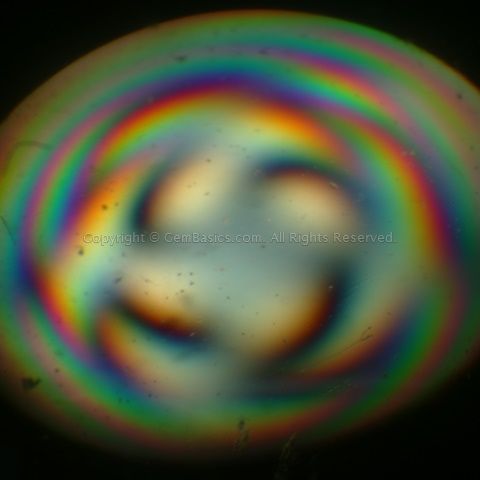
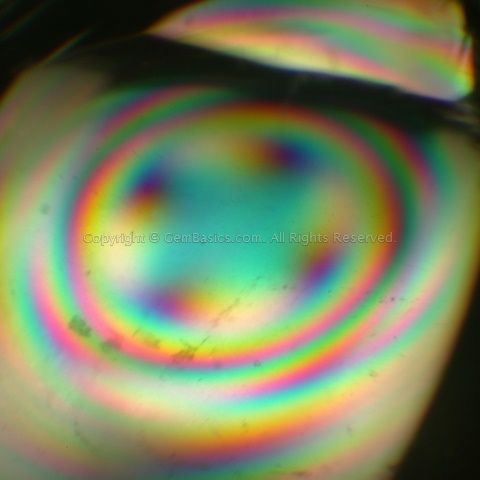
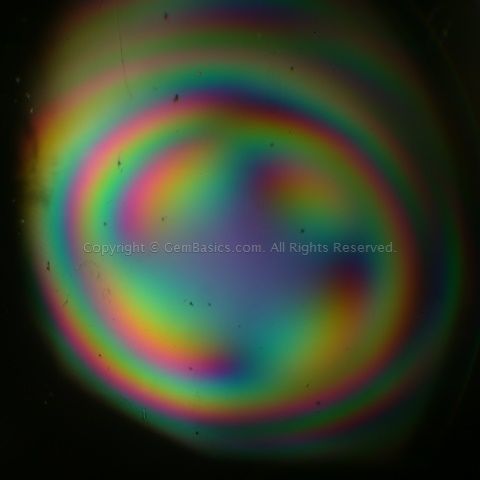
A diagnostic tool for the identification of quartz, whether it is natural or synthetic, is - besides a refractometer - conoscopy. When a bull's eye is observed through a conoscope (viewed in the direction of the optic axis) between crossed polarising filters, the gem under examination is quartz.
But also lookalikes can be separated by this optic axis figure. The bull's eye immediately tells the difference between scapolite which is of a similar refractive index and will therefore lead to almost the same readings on a refractometer. Conoscopy will reveal a cross for scapolite.
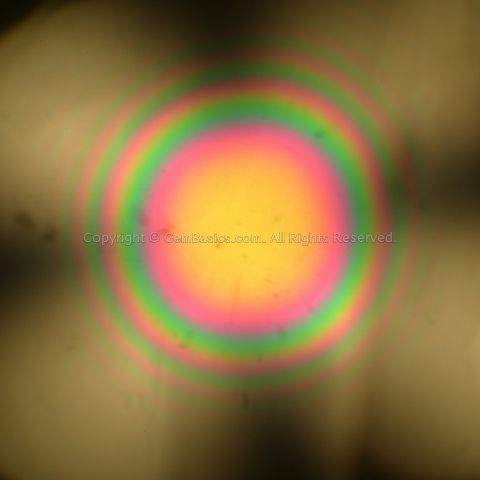
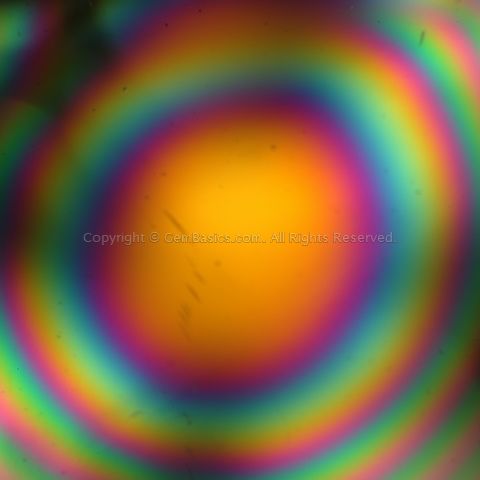
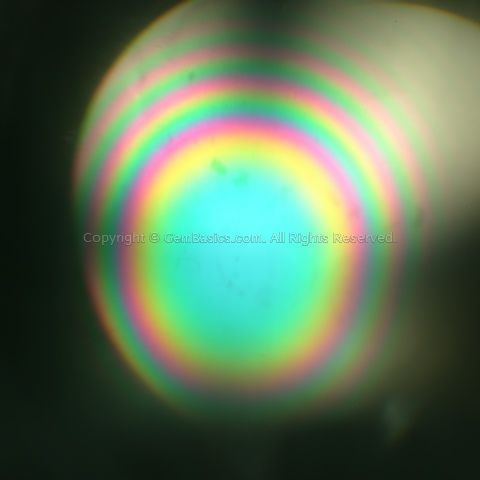

 LoRes.jpg)